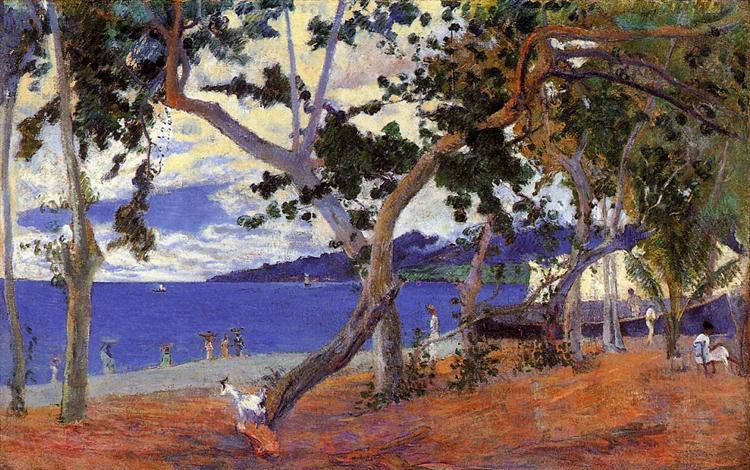Descrizione
Paul Gauguin's painting "Coastal Landscape of Martinique" (1887) encapsulates the artist's relentless search for a deeper and more symbolic expression of reality, in a context where nature and everyday life are intertwined with the emotionality of its colors and shapes. This work is presented as a testimony of his trip to the Caribbean island of Martinique during a time when he was exploring the rich culture and landscape that surrounded him, influenced by both local traditions and his own artistic concerns.
Gauguin, a central figure of Post-Impressionism, is known for his break with naturalistic representation, and in this work he offers us a landscape that, while respecting the essence of the Caribbean environment, escapes direct representation in favour of a more subjective interpretation. The composition is dominated by a vibrant palette, where the lush greens of the vegetation clash with the intense blues of the sky and sea. The choice of these colours shows his interest in the emotive effects of chromatics, a distinctive feature of his style. The tones are not merely representative; they take on a symbolic value that suggests both life and spirituality.
At the centre of the composition, the softness of the shapes gives the viewer a moment of contemplation. The horizon is drawn in an organic way, suggesting a distance that invites the observer to lose themselves in the depth of the landscape. The shape of the mountains and the coastline seem to dance in a kind of natural rhythm, reflecting an intimate connection between man and his environment, a recurring theme in Gauguin's work.
While there are no prominent human figures in this landscape, the absence of characters in the painting does not strip the work of humanity. Instead, the depiction of vibrant nature may suggest an ethereal presence of those who inhabited this land, emphasizing the almost spiritual relationship the artist felt toward his context. This marks a notable difference from many contemporary works by other artists, who often included figures to tell explicit stories.
Gauguin moved away from the impressionist legacies of his time, and Coastal Landscape of Martinique acts as a vehicle towards symbolism. This can be seen as a transition in his own work, where the exploration of identity and sense of place begins to gain momentum. The work can be thematically related to his later series on Tahiti, where he also sought to understand and reinterpret the essence of the landscape and its cultural context.
As one analyses the artist's brushstrokes, one sees his characteristically loose and expressive technique, which contrasts with the precision of Impressionism. In this painting, the obviousness of form and colour become an innovative visual expression that challenges the normativity of the time, laying the groundwork for future artistic movements that would question the conventions of representation.
In conclusion, "Coastal Landscape of Martinique" is not only a visual testimony of a landscape, but a profound exercise of introspection and connection, a reflection of Paul Gauguin's continuous search for new ways to communicate the beauty and spirit of the world. This work illustrates not only his innate talent, but also his artistic evolution, which would lay the foundations for modernity in painting, a legacy that endures over time and continues to inspire generations.
KUADROS ©, a famous painting on your wall.
Hand-made oil painting reproductions, with the quality of professional artists and the distinctive seal of KUADROS ©.
Painting reproduction service with satisfaction guarantee. If you are not completely satisfied with the replica of your painting, we will refund 100% of your money.

